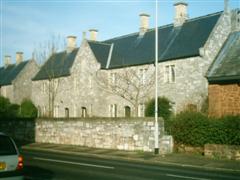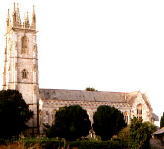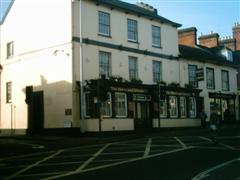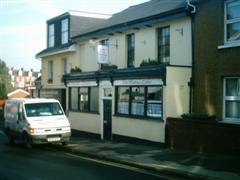
|

|
| Use the text links for more information! |
|
Next stop is in Heavitree itself. Walk up Magdalen
Road, you'll pass Magdalen Road Garages on your right, built 1933. The garage was
originally Warren Garage and was known for quite a time as Motor Mecca. Kastner's have
however been in there for several years.
College Avenue is on your left, this was once the site of Magdalen Gallows. The open fields are St Luke's Playing Fields, after which you'll pass Baring Cresent. Pass the traffic lights and into Livery Dole. On your left are Livery Dole Almshouses and Chapel. The Almshouses were founded by Sir Dennis Knight in March 1591 and finished by Sir Thomas Dennis, his son in 1594. The chapel was first mentioned in 1439 as the Chapel of St Clarus, and may well have been associated with the execution of criminals. Beyond the chapel is the Gordon Lamp, dedicated to the memory of General Gordon after his death in 1885 while defending Khartoum. You must have seen the film. The general was a friend of the Vicar of Heavitree, Prebendary Barnes and he paid for the lamp to be erected. You are now in Fore Street, Heavitree. Keep walking on the RHS of the road. |

|
|
During the Victorian and Georgian
era, Heavitree became an upper class residential village, socially and
geographically distinct from Exeter. It was inevitable however that
Heavitree would eventually become part of Exeter and it did so in 1913
after a great deal of resistance from its tight but wealthy residents who
weren't too happy about paying the increased rates. Lets hope they were
all band Z. The building next door to The Heavitree used to house Heavitree's
Fire Engine, but this closed when everything was based centrally at the Danes Castle
headquarters of the Exeter Fire Brigade
in 1932. The building is now part of the extended pub.
Execution
Livery Dole at the brow of Heavitree Road was a place of execution until 1531. The last person to be executed here was Thomas Benet who was burned at the stake for his religious beliefs. It was a brutal execution involving burning furze being pushed into his mouth when he would not deny the heresy of his son who had put a message on the Cathedral's west door saying that the pope was an anti christ. |
|
Two monuments were built in his
memory, one at the Almshouses at Livery Dole and a pillar of Dartmoor Granite
in Denmark Road. In 1851, the iron ring which went around the victims bodies
and the chain which attached them to the stake were found.
A later site for executions was Ringwell, close to the junction of Sidmouth Road and Honiton Road. Ringswell Avenue is close by. 1926 saw the unearthing of skeletons from around here and further finds were made in 1973. Horse drawn carts brought the condemned to Heavitree Bridge (Honiton Road / Rifford Road / Sweetbrier Lane), where the prisoners took their last drink from a spring coming from the side of the hill. Further along Honiton Road is a bridge over which passes the road to Pinhoe. This is Gallows Bridge. |
| Old School but no tie
St Lukes High School (formerly Vincent Thompson and my old school), is built on land that
in Victorian times was home to a point to point race meeting, the Heavitree
Races. The course was about 1 1/2 miles long and thousands of people attended,
taking 'ordinary' meals in the Heavitree pubs afterwards. The parish
of Heavitree has a population of 22,000, the third largest in Devon and
has 3 churches and a chapel.
The oldest church is St. Michael's. Heavitree
was for centuries the centre of the Saxon Kings Manor of Wonford, despite
being well outside the walled city. It is thought that courts and councils
were held on the site of St. Michael's by a great tree beside the Roman
road into Exeter which is now Fore Street Heavitree.
It is possible that a church was built on this site before AD700
and that the name Heavitree comes from 'Hefa's tree' or heafod treow (the
chief tree). A 12th century church was altered in the 14th and 15th centuries
and completely restored in 1541. Rebuilding of the nave took place in
between 1844 and 1846 and the tower erected for the Queen's jubilee in
1887, leaving what we see today. For a good view of the church, head down
between the Ship & Pelican and Horse & Groom. Its on your right.
Eight bells were hung in the tower in 1897 and these were overhauled in
1993.
|
Vincent Thompson was a City councillor. He reported on the Ministry of Transport experiments
with traffic lights in the City. His report noted that the experiment was a failure and that no more
traffic lights should be installed at the City's expense.
 |
 |
| Heavitree Brewery
Just up from the Church was the site of the old Heavitree Brewery.
The company still exists at Trood Lane, Matford,
although brewing ceased in 1970 when Whitbread were brought in to supply
its 120 tied houses.
A small family business was established in 1790 and was flourishing by the
early 19th century, it was at the time headed by Thomas Buller Wolland.
His sister, Elizabeth married Thomas R. Baker (an Exeter iron merchant),
who in 1837 sold his business with the intention of entering into partnership
with his brother in law in the beer business. Unfortunately he dropped
dead a few months later.
Wolland then saw that his widowed sister take over the business, so business
was conducted in her name until her death in 1889.
Trade was good and the firm became Baker & Son in 1860 when
NG Baker joined the firm. NG Baker realised his asset in 1890 when Heavitree
Brewery Ltd was formed. He also joined the board of the new company. |
Windsor Brewery
The company expanded by buying public houses, one of the earliest was the Horse
and Groom in 1891. Heavitree Brewery also swallowed up the rival Windsor
Brewery in 1899, shutting it down in 1902.
They accquired George Finch's Eagle Brewery in Exeter (38 North St, 144 Fore St) and Pinsents of Newton Abbot.
A Mr Gall was appointed secretary in 1916. He systematically robbed the brewery
reducing them to financial ruin by 1922.
One of the company's creditors, John Tucker bought a major shareholding after
this and was able to take the company to new heights with the help of his friend HC Hammars.
Expansion re-started with the acquisition of further local breweries. 1970 saw the
final brew in Church Street.
The Maltings replaced the brewery, the only building remaining linked to the brewery is the
Cooperage in Sivell Place which has now been incorporated into a home.
Heavitree Brewery Cooperage |
 |
 |